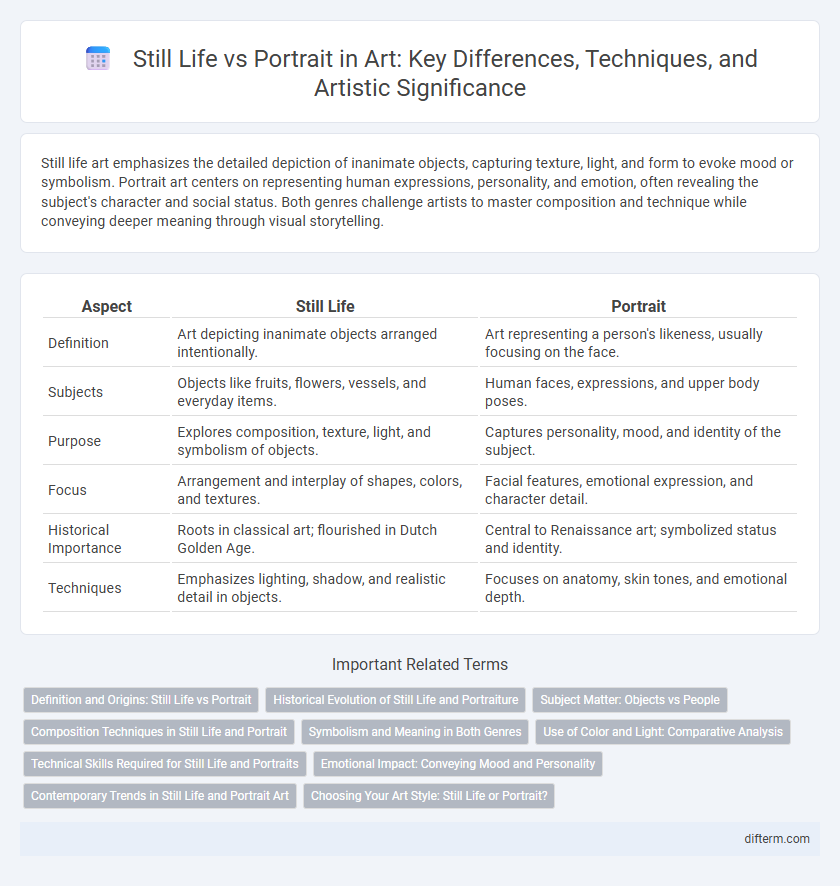Still life art emphasizes the detailed depiction of inanimate objects, capturing texture, light, and form to evoke mood or symbolism. Portrait art centers on representing human expressions, personality, and emotion, often revealing the subject's character and social status. Both genres challenge artists to master composition and technique while conveying deeper meaning through visual storytelling.
Table of Comparison
| Aspect | Still Life | Portrait |
|---|---|---|
| Definition | Art depicting inanimate objects arranged intentionally. | Art representing a person's likeness, usually focusing on the face. |
| Subjects | Objects like fruits, flowers, vessels, and everyday items. | Human faces, expressions, and upper body poses. |
| Purpose | Explores composition, texture, light, and symbolism of objects. | Captures personality, mood, and identity of the subject. |
| Focus | Arrangement and interplay of shapes, colors, and textures. | Facial features, emotional expression, and character detail. |
| Historical Importance | Roots in classical art; flourished in Dutch Golden Age. | Central to Renaissance art; symbolized status and identity. |
| Techniques | Emphasizes lighting, shadow, and realistic detail in objects. | Focuses on anatomy, skin tones, and emotional depth. |
Definition and Origins: Still Life vs Portrait
Still life art captures inanimate objects such as flowers, fruits, and everyday items, originating from ancient Egyptian and Roman traditions emphasizing symbolic arrangements. Portrait art focuses on representing human subjects, tracing its roots back to prehistoric cave paintings and evolving through classical antiquity to capture likeness and character. Both genres serve distinct narrative and aesthetic purposes, reflecting cultural values and artistic techniques from their historical origins.
Historical Evolution of Still Life and Portraiture
Still life and portraiture evolved distinctly through art history, with still life emerging prominently during the Renaissance as artists explored realism and symbolism in everyday objects, while portraiture has ancient roots, tracing back to Egyptian funerary art emphasizing identity and status. The Dutch Golden Age in the 17th century marked a peak in still life painting, showcasing mastery over texture and light to symbolize wealth and mortality, whereas portraiture advanced in Renaissance Italy through innovations in perspective and human anatomy to capture psychological depth. Both genres reflect cultural shifts and technological advancements, with still life highlighting material culture and portraiture focusing on individual identity and social hierarchy.
Subject Matter: Objects vs People
Still life art focuses on inanimate objects such as fruits, flowers, and household items arranged to convey symbolism, texture, and composition. Portrait art centers on humans, capturing facial expressions, emotions, and individual personality to create a connection with the viewer. The subject matter defines the emotional impact and narrative, with still life emphasizing arrangement and color, while portraits prioritize likeness and character.
Composition Techniques in Still Life and Portrait
Still life compositions emphasize the deliberate arrangement of inanimate objects to create balance, contrast, and focal points, often utilizing the rule of thirds, leading lines, and controlled lighting to enhance texture and depth. Portrait compositions focus on positioning the subject to convey emotion and personality, employing techniques like the use of negative space, eye-level angles, and framing elements such as hands or props to direct viewer attention. Both genres rely on careful consideration of color harmony and spatial relationships to evoke mood and narrative effectively.
Symbolism and Meaning in Both Genres
Still life paintings use objects like fruits, flowers, and everyday items to symbolize themes such as mortality, abundance, and the passage of time, often reflecting deeper philosophical or religious meanings. Portraits capture the essence of an individual, using facial expressions, attire, and background elements to convey identity, social status, and personal emotions. Both genres utilize symbolism to communicate complex narratives, where still life emphasizes universal concepts while portraits focus on personal story and character.
Use of Color and Light: Comparative Analysis
Still life paintings often utilize controlled lighting and color palettes to emphasize texture, form, and composition, highlighting the intricate details of inanimate objects. Portraits typically employ color and light to capture mood, emotion, and personality, using contrasts and shadows to enhance facial features and expressions. The deliberate manipulation of light and color in each genre reflects their distinct artistic objectives: still life prioritizes structural clarity, while portraiture focuses on psychological depth.
Technical Skills Required for Still Life and Portraits
Still life painting demands precise control of light, shadow, and texture to realistically capture inanimate objects, emphasizing composition and color harmony. Portrait painting requires mastery of anatomy, facial expression, and skin tones to convey personality and emotion accurately. Both genres necessitate advanced skills in observation, brushwork, and color theory but differ in their focus on subject liveliness versus structural detail.
Emotional Impact: Conveying Mood and Personality
Still life compositions evoke emotional impact through symbolic objects and meticulous arrangement, creating moods that reflect themes like tranquility or decay. Portraits convey personality and emotion by capturing facial expressions, eye contact, and body language, offering insight into the subject's inner life. The interplay of color, lighting, and composition in both still life and portrait art intensifies the viewer's emotional connection and narrative interpretation.
Contemporary Trends in Still Life and Portrait Art
Contemporary still life art incorporates dynamic compositions and mixed media, emphasizing abstraction and conceptual themes that challenge traditional representations of everyday objects. Portrait art increasingly explores identity and social narratives through experimental techniques such as digital manipulation and immersive installations. Both genres blur boundaries, reflecting current cultural discourses and technological innovations in the art world.
Choosing Your Art Style: Still Life or Portrait?
Choosing between still life and portrait art styles depends on your interest in capturing objects or human emotions. Still life emphasizes composition, lighting, and texture to create meaningful arrangements of inanimate items, while portraiture focuses on conveying personality and expression through facial features and posture. Understanding the technical skills and emotional depth each style requires helps artists decide which aligns best with their creative vision.
Still life vs portrait Infographic

 difterm.com
difterm.com